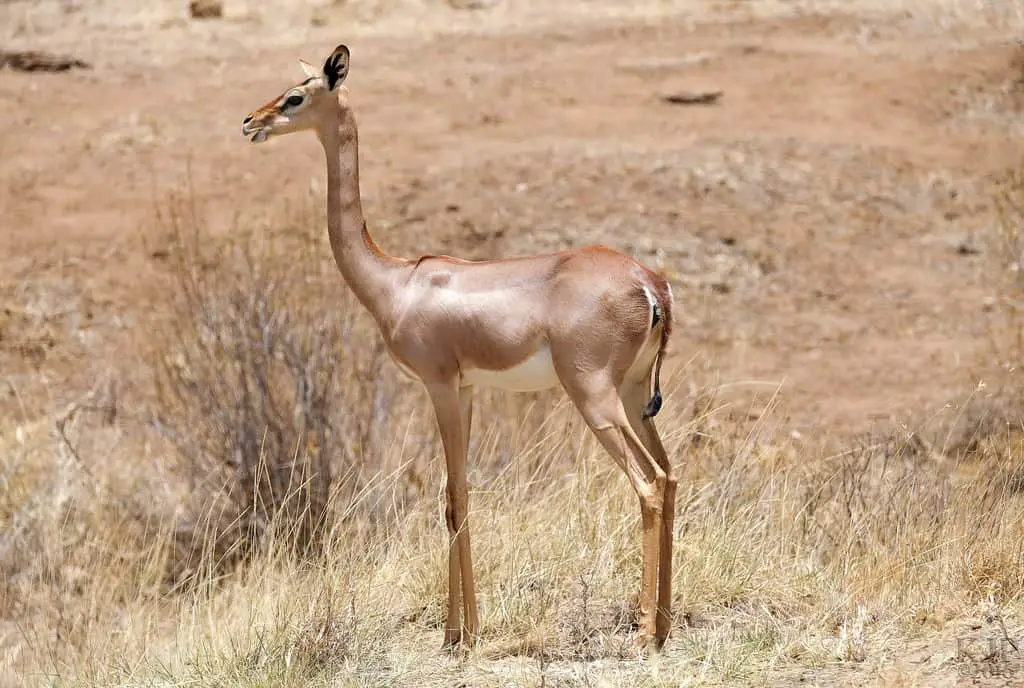Table of Contents
*This post may contain affiliate links. As an Amazon Associate we earn from qualifying purchases.
There is still some mystery and mystic left in the wild. It is a bit of a treat to learn about lesser-known species of animals.
There are animals, which are not commonly known, like many others. But yet, they are under threat and man’s activities are influencing their existence.
We can easily relate to the plight of the polar bears in the Arctic. We can easily relate to the overfishing activities that threaten the whale pollution in areas of Asia. That is because their situation is widely advertised. But, what about those animals in other parts of the world like Africa?
Yes, the elephant, rhinos and other lesser-known animals of the African bush, like the gerenuk.
Today, we will take some time to explore and learn about this gorgeous antelope and giraffe-like creature. Will also learn how tall is a gerenuk.
Learn More About The Gerenuk
You can consider these animals as a cousin of the gazelle. They are a part of the antelope family and scientifically referred to as Litocranius walleri.
When you look at them, you might think that there are not many differences between it and the gazelle. However, its long neck is one of the more exceptional and distinguishing features.
But, its skull is a bit more solid than the gazelle as well.
The people of Somali call it ‘Gerenuk’ meaning ‘Giraffe Necked’. But in other areas, it is also called ‘Wallers Gazelle’.
Physical Description Of The Animal

Via Giphy
Apart from its elongated neck. The eyes and ears on this animal are quite large and noticeable. Their heads look disproportionate to their body because it is of a smaller size.
The female gerenuks look a little daintier than the males. They have a muscular neck, also, only they have horns. These horns are a great deal ringed and heavy.
Typically, the animal is approximately 150 centimeters long, with the male being bigger.
In terms of height, the female ranges about 80 to 100 centimeters. But the male averages 89 to 105 centimeters. Females weigh a lot less, about 68 pounds. But the males can weigh upwards of 100 pounds.
Their underparts have a lighter color than their largely brown coat. And their tails are just a black tuft of hair, which is quite short.
You might be interested to note, that they also have pre-orbital glands like the gazelles. It is located at the front of their eyes. The tar substance, which is excreted, is rubbed on bushes and trees.
This is how they mark their territory with scent.
Also, they can excrete more scent substance from their knees and between their split hooves. At the knee position, there are more glands. But they are typically hidden by hair.
The Habitat Of The Animal

Via Giphy
This animal lives in areas of Tanzania, Kenya, Somalia and Ethiopia.
Because it is a prey, it does not prefer areas with the vast open land where it can be spotted by many predators. However, it lives in areas of these countries, which has thickets, especially dry, flat thorn bush, open scrublands and woody vegetation
Diet Of The Animal

Via Giphy
Being a herbivore in Africa can be tedious at times. They have to move about because of the effects of drought or dry season on the land. But the gerenuk is a flexible eater.
Those long necks give them an advantage.
They are able to climb up and nibble from the higher branches of trees and other plants. While standing on their hind legs, they can get as far up as seven to nine feet. When necessary they use their front legs to pull down branches as well.
Other kinds of antelopes are generally eating their meal at the ground level.
The animal’s flexibility allows them to survive better in the drier regions of the scrublands and deserts. Another interesting fact is that most of its water intake comes from the plants that it consumes.
Their diet generally has a bit of bud, fruits, flowers, shoots or leaves from trees and bushes.
The Animals Behavior
This animal prefers living in a pack. Survival is better this way. You will either see them in a pack with just solitary males or ones with females and their little ones.
The female groups tend to roam upwards of two miles. As you can imagine the males will not mind females passing through their territory. But the males stick to a smaller region.
The Reproductive Cycle Of The Gerenuk
These antelopes have no specific breeding season. Their eating habits allow them some flexibility.
The female is not ready to mate until she is about one year old. However, the males take a bit longer. They typically begin mating at about one and a half years old.
When it is time to mate, the male approaches a female and performs several mating antics. He will come up to the female and tap her on her flanks with his legs. This he will do a number of times.
The male is also known to put his scent on the female by rubbing on her with his preorbital glands. This you will recall is at his eyes.
After mating, it takes about seven months for a female to give birth to one calf.
Their birthing experience usually takes place in a solitary sport, which is located away from the herd. Young calves weigh approximately six and a half pounds.
Nothing is left to waste in this birthing process either. She will eat up the afterbirth and clean up her young calf with her tongue.
Hiding Her Young And Masking Its Scent
Then, she will go away to scavenge for food and return several times a day to let her young suckle on some life-sustaining milk. He or she will not be moved for several months.
This allows them to gain weight and get stronger.
Again, several times during the day, she tries to mask the location of her young by cleaning him or her with her tongue. Then, she makes sure to eat up its poop, so that no scent goes out to predatory animals that may be lurking about the area.
The mother will communicate with soft bleats to her young, being careful not to draw any attention. Traditionally, they live upwards of thirteen years in captivity. But in the wild, they average about eight years.
They are hunted not only by humans but also by jackals, lions, leopards, cheetahs and wild dogs.
Conservation Status Of The Gerenuk
As mentioned earlier, these animals are being impacted by human activity. They do have problems with finding mates as well.
Their numbers are dwindling at a fast pace. For this reason, they have a ‘Conservation Dependent’ status, which has been assigned by the IUCN.
One area that has been designated for them is the Kitengela Land Conservation in Kenya. But even here, they are under threat.
“Launched in 2008, the Kitengela Conservation Project aims to prevent further degradation of the region and to find solutions that allow the Maasai communities and wildlife to peacefully coexist. The program has so far supported the development of a land-use master plan that lays out community-driven guidelines on the sustainable land use and natural resource management in the area.”
If you wish to support the plight of the gerenuk, visit the African Wildlife website and you can donate or support their cause in other ways.
In this, you can help them with preserving conservations like that of the Kitengela Conservation Project and the animals that live there.
Explore The African Continent For A Look At The Gerenuk

Via Giphy
It might be interesting to learn that all that time you have been watching your African safari shows, what you think was a gazelle, was actually a gerenuk.
They do have similar features. And, they can be easily mistaken for their cousins, the gazelle.
These slender creatures deserve our attention. Because man’s activities are intruding on their territories. This causes them to become more exposed and displaced.
Presently there are fewer than 100,000 of them out in the wild support this cause and help to protect the gerenuk of the South Eastern African countries.

